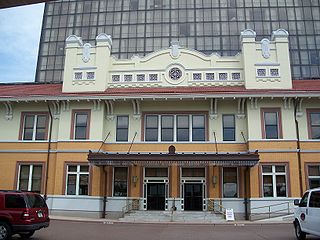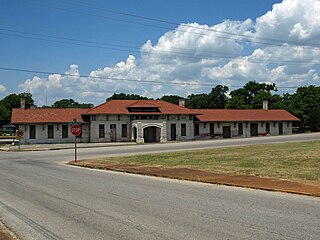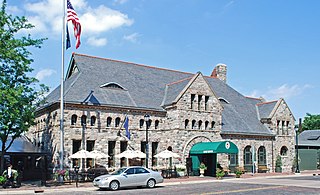
Lyons is a New Jersey Transit station in Basking Ridge, New Jersey along the Gladstone Branch of the Morris & Essex Lines. The station serves south Basking Ridge as well as the Hills and Liberty Corner.

The Louisville and Nashville Passenger Station and Express Building is a historic Louisville and Nashville Railroad passenger train depot in Pensacola, Florida.

Montgomery Union Station and Trainshed is a historic former train station in Montgomery, Alabama. Built in 1898 by the Louisville and Nashville Railroad, rail service to the station ended in 1979 and it has since been adapted for use by the Montgomery Area Visitor Center and commercial tenants. It was added to the National Register of Historic Places in 1973 and became a National Historic Landmark in 1976.

Tallahassee station, also known as the Jacksonville, Pensacola and Mobile Railroad Company Freight Depot, is a historic train station in Tallahassee, Florida. It was built in 1858 and was served by various railways until 2005, when Amtrak suspended service due to Hurricane Katrina. It was added to the National Register of Historic Places in 1997.
The Louisville and Nashville Depot, or Louisville and Nashville Railroad Depot or Louisville and Nashville Passenger Station, Louisville and Nashville Railroad Passenger Depot or variations, may refer to the following former and active train stations previously used by the Louisville and Nashville Railroad. Some of these are listed on the National Register of Historic Places (NRHP).

The Historic Railpark and Train Museum, formerly the Louisville and Nashville Railroad Station in Bowling Green, Kentucky, is located in the historic railroad station. The building was placed on the National Register of Historic Places on December 18, 1979. Opened in 1925, the standing depot is the third Louisville & Nashville Railroad depot that served Bowling Green.

The Gulf, Mobile and Ohio Passenger Terminal is a historic train station in Mobile, Alabama, United States. Architect P. Thornton Marye designed the Mission Revival style terminal for the Mobile and Ohio Railroad. It was completed in 1907 at a total cost of $575,000. The Mobile and Ohio merged with the Gulf, Mobile and Northern Railroad in 1940 to form the Gulf, Mobile and Ohio Railroad.

Adams is a former train station at 10 Pleasant Street in Adams, Massachusetts. Built in 1899, it served as the town's principal rail station on the North Adams Branch of the Boston and Albany Railroad until the mid-20th century. The surviving buildings were listed on the National Register of Historic Places in 1982 as the Pittsfield & North Adams Passenger Station and Baggage & Express House. The former station is currently the home of a sports bar and restaurant.

Lehigh Valley Railroad Station is a historic railway station located at Rochester in Monroe County, New York. The Lehigh Valley Railroad built the station in 1905 but stopped using the station for passenger service in the 1950s. Later the station was used as a bus terminal and then as a night club. In the 1980s the building was added to the National Register of Historic Places and today it houses the Dinosaur Bar-B-Que restaurant.

The Nevada–California–Oregon Railway Passenger Station is a historic train station in Lakeview, Oregon, United States. It was built in 1912 by contractor I. A. Underwood from plans by architect Frederic DeLongchamps. It was the northern terminus of the Nevada–California–Oregon Railway. The Southern Pacific Railroad company owned and operated the depot from 1928 until 1975, when it was closed. Since 1978, the building has been used as a law office and later a private residence. Because of its importance to local history, the depot was listed on the National Register of Historic Places in 1983.

The Louisville and Nashville Depot is a historic railroad station in Evergreen, Conecuh County, Alabama, United States.

The Louisville and Nashville Depot, located at 101 East Railroad Street in Nashville, Illinois, is the city's former Louisville and Nashville Railroad station. The station was built in 1885 as part of the L&N's expansion through Southern Illinois in the 1880s. The building has a simple vernacular design common to L&N depots in small towns, which were intended to be functional rather than elaborate. The railroad exported the products of Washington County's industries, which included coal, dairy products, grain, and lumber, through the station; it also imported goods such as automobiles, fertilizer, and commercial products. In addition, the railroad provided passenger service to Nashville; at the peak of service, seven daily passenger trains stopped at the depot, and students in other parts of the county used the trains to attend Nashville's high school. The depot also served as an information center for Nashville; the city's telegraph station was located at the depot, and St. Louis daily newspapers arrived by train. The depot remained in service as late as the 1950s but closed sometime prior to 1984.

The Western and Atlantic Depot is a historic Western and Atlantic Railroad train depot in Dalton, Georgia. It was built in 1852 in the Greek Revival style. The building is the oldest surviving commercial structure in Dalton and is a "fine example" of depot architecture in Georgia in the mid-1800s. It served as both a freight and passenger station.

The Albertville Depot, also known as L&N Railroad Depot, is a historic train depot in Albertville, Alabama. It was built by the Nashville, Chattanooga and St. Louis Railway in 1892, one year after the town was incorporated. The building measures 112 by 40 feet, and is divided into three rooms: two offices and one larger warehouse space.

The Hartselle Downtown Commercial Historic District is a historic district in Hartselle, Alabama. The town was founded in 1870 when the Louisville and Nashville Railroad was extended south to Birmingham and Mobile. Hartselle quickly grew into a transportation hub for shipping timber and cotton. The town was devastated by two fires, in 1901 which destroyed all commercial buildings east of the railroad tracks, and in 1916 where twenty-one buildings including the passenger and freight depots were destroyed. Only nine buildings survived the 1916 fire. After an initial building boom from 1916 through 1920, development slowed due to low farming prices after World War I and the Great Depression. Notable structures in the district are the hip roofed L&N passenger depot and two-story freight depot and the Colonial Revival post office. Of the commercial buildings, 51 are one story, 14 are two stories, and 1 is three stories. The district was listed on the National Register of Historic Places in 1999.

The Southern Railway Depot is a historic building in Decatur, Alabama. The depot was built in 1904–05 along the Southern Railway line. Decatur had become a transportation hub of North Alabama by the 1870s, with its connections to the Tennessee River, the east–west Tuscumbia, Courtland and Decatur Railroad, and the north–south Louisville and Nashville Railroad.

The Louisville and Nashville Railroad Depot is a historic train station in Cullman, Alabama. The depot was built in 1913 as a replacement for Cullman's original station. Cullman's founder, John G. Cullmann, gave money to the city upon his death in 1895 to lower the Louisville and Nashville Railroad tracks through town, in order to reduce noise and pollution. The plan was not enacted until 1911, when the L&N laid double tracks through the town, necessitating the construction of a new depot. The depot served passengers until 1968, and was used for maintenance storage by new owners CSX until it was sold to the city in 1990. It was restored and now houses offices for the local United Way chapter.

The Alabama Midland Railway Depot is a historic train station in Ashford, Alabama. Ashford was founded in 1891 along the Alabama Midland Railway line between Montgomery and Bainbridge, Georgia. The depot was built the next year, and served as the commercial hub of the town. The Alabama Midland became part of the Plant System is 1894, which was taken over by the Atlantic Coast Line Railroad in 1901 and merged into the Seaboard Coast Line Railroad in 1967. Nearly all of the downtown area was destroyed in a fire in 1915, but the depot survived. The depot closed in 1978, and was renovated as an event space in 2005.

The Dothan station, also known as Atlantic Coastline Railroad Passenger Depot, is a historic train station in Dothan, Alabama. It was built in 1907 as the largest and busiest on the Atlantic Coast Line Railroad between Montgomery, Alabama, and Thomasville, Georgia and replaced a former freight depot. The Atlantic Coast Line merged with the Seaboard Air Line Railroad in 1967 to form the Seaboard Coast Line Railroad. In 1971, Amtrak took over passenger rail service in the United States and Dothan station was served by the Floridian until 1979.

The Ann Arbor station is a former Michigan Central Railroad station located at 401 Depot Street in Ann Arbor, Michigan. It was converted into a restaurant, the Gandy Dancer, in 1970, and listed on the National Register of Historic Places as Michigan Central Railroad Depot in 1975.























